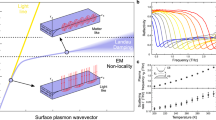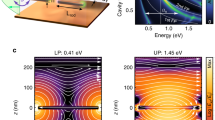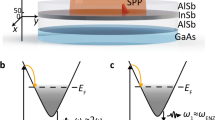Abstract
Surface plasmon polaritons (SPPs) are electron density waves excited at the interfaces between metals and dielectric materials1. Owing to their highly localized electromagnetic fields, they may be used for the transport and manipulation of photons on subwavelength scales2,3,4,5,6,7,8,9. In particular, plasmonic resonant cavities represent an application that could exploit this field compression to create ultrasmall-mode-volume devices. A key figure of merit in this regard is the ratio of cavity quality factor, Q (related to the dissipation rate of photons confined to the cavity), to cavity mode volume, V (refs 10, 11). However, plasmonic cavity Q factors have so far been limited to values less than 100 both for visible and near-infrared wavelengths12,13,14,15,16. Significantly, such values are far below the theoretically achievable Q factors for plasmonic resonant structures. Here we demonstrate a high-Q SPP whispering-gallery microcavity that is made by coating the surface of a high-Q silica microresonator with a thin layer of a noble metal. Using this structure, Q factors of 1,376 ± 65 can be achieved in the near infrared for surface-plasmonic whispering-gallery modes at room temperature. This nearly ideal value, which is close to the theoretical metal-loss-limited Q factor, is attributed to the suppression and minimization of radiation and scattering losses that are made possible by the geometrical structure and the fabrication method. The SPP eigenmodes, as well as the dielectric eigenmodes, are confined within the whispering-gallery microcavity and accessed evanescently using a single strand of low-loss, tapered optical waveguide17,18. This coupling scheme provides a convenient way of selectively exciting and probing confined SPP eigenmodes. Up to 49.7 per cent of input power is coupled by phase-matching control between the microcavity SPP and the tapered fibre eigenmodes.
This is a preview of subscription content, access via your institution
Access options
Subscribe to this journal
Receive 51 print issues and online access
$199.00 per year
only $3.90 per issue
Buy this article
- Purchase on Springer Link
- Instant access to full article PDF
Prices may be subject to local taxes which are calculated during checkout




Similar content being viewed by others
References
Raether, H. R. Surface Plasmons on Smooth and Rough Surfaces and on Gratings (Springer, 1988)
Barnes, W. L., Dereux, A. & Ebbesen, T. W. Surface plasmon subwavelength optics. Nature 424, 824–830 (2003)
Maier, S. A. et al. Local detection of electromagnetic energy transport below the diffraction limit in metal nanoparticle plasmon waveguides. Nature Mater. 2, 229–232 (2003)
Stockman, M. I. Nanofocusing of optical energy in tapered plasmonic waveguides. Phys. Rev. Lett. 93, 137404 (2004)
Ozbay, E. Plasmonics: Merging photonics and electronics at nanoscale dimensions. Science 311, 189–193 (2006)
Cubukcu, E., Kort, E. A., Crozier, K. B. & Capasso, F. Plasmonic laser antenna. Appl. Phys. Lett. 89, 093120 (2006)
Lopez-Tejeira, F. et al. Efficient unidirectional nanoslit couplers for surface plasmons. Nature Phys. 3, 324–328 (2007)
Lal, S., Link, S. & Halas, N. J. Nano-optics from sensing to waveguiding. Nature Photon. 1, 641–648 (2007)
Brongersma, M. L. & Kik, P. G. Surface Plasmon Nanophotonics (Springer, 2007)
Vahala, K. J. Optical microcavities. Nature 424, 839–846 (2003)
Noda, S., Fujita, M. & Asano, T. Spontaneous-emission control by photonic crystals and nanocavities. Nature Photon. 1, 449–458 (2007)
Ditlbacher, H. et al. Silver nanowires as surface plasmon resonators. Phys. Rev. Lett. 95, 257403 (2005)
Bozhevolnyi, S. I., Volkov, V. S., Devaux, E., Laluet, J.-Y. & Ebbesen, T. W. Channel plasmon subwavelength waveguide components including interferometers and ring resonators. Nature 440, 508–511 (2006)
Miyazaki, H. T. & Kurokawa, Y. Squeezing visible light waves into a 3-nm-thick and 55-nm-long plasmon cavity. Phys. Rev. Lett. 96, 097401 (2006)
Weeber, J.-C., Bouhelier, A., Colas des Francs, G., Markey, L. & Dereux, A. Submicrometer in-plane integrated surface plasmon cavities. Nano Lett. 7, 1352–1359 (2007)
Vesseur, E. J. R. et al. Surface plasmon polariton modes in a single-crystal Au nanoresonator fabricated using focused-ion-beam milling. Appl. Phys. Lett. 92, 083110 (2008)
Cai, M., Painter, O. & Vahala, K. J. Observation of critical coupling in a fiber taper to a silica-microsphere whispering-gallery mode system. Phys. Rev. Lett. 85, 74–77 (2000)
Spillane, S. M., Kippenberg, T. J., Painter, O. J. & Vahala, K. J. Ideality in a fiber-taper-coupled microresonator system for application to cavity quantum electrodynamics. Phys. Rev. Lett. 91, 043902 (2003)
Kippenberg, T. J., Kalkman, J., Polman, A. & Vahala, K. J. Demonstration of an erbium-doped microdisk laser on a silicon chip. Phys. Rev. A 74, 051802(R) (2006)
Borselli, M., Johnson, T. J. & Painter, O. Beyond the Rayleigh scattering limit in high-Q silicon microdisks: theory and experiment. Opt. Express 13, 1515–1530 (2005)
Armani, D. K., Kippenberg, T. J., Spillane, S. M. & Vahala, K. J. Ultra-high-Q toroid microcavity on a chip. Nature 421, 925–929 (2003)
Spillane, S. et al. Ultra-high-Q toroidal microcavities for cavity quantum electrodynamics. Phys. Rev. A 71, 013817 (2005)
Oxborrow, M. Traceable 2-D finite-element simulation of the whispering-gallery modes of axisymmetric electromagnetic resonators. IEEE Trans. Microw. Theory Tech. 55, 1209–1218 (2007)
Johnson, P. B. & Christy, R. W. Optical constants of noble metals. Phys. Rev. B 6, 4370–4379 (1972)
Palik, E. D. Handbook of Optical Constants of Solids (Academic, 1985)
Rowland, D. R. & Love, J. D. Evanescent wave coupling of whispering gallery modes of a dielectric cylinder. IEE Proc. J. Optoelectron. 140, 177–188 (1993)
Hill, M. T. et al. Lasing in metallic-coated nanocavities. Nature Photon. 1, 589–594 (2007)
Almeida, V. R., Barrios, C. A., Panepucci, R. R. & Lipson, M. All-optical control of light on a silicon chip. Nature 431, 1081–1084 (2004)
Gong, Y. Y. & Vučković, J. Design of plasmon cavities for solid-state cavity quantum electrodynamics applications. Appl. Phys. Lett. 90, 033113 (2007)
Akimov, A. V. et al. Generation of single optical plasmons in metallic nanowires coupled to quantum dots. Nature 450, 402–406 (2007)
Acknowledgements
We thank R. F. Oulton and G. Bartal for discussions and S. Zhang for a critical reading of the manuscript. This work was supported by the US Air Force Office of Scientific Research MURI program (grant no. FA9550-04-1-0434) and by the NSF Nanoscale Science and Engineering Center under award no. DMI-0327077.
Author information
Authors and Affiliations
Corresponding authors
Supplementary information
Supplementary Information
This file contains a Supplementary Discussion and Notes, Supplementary Figures S1-S5 with Legends and Supplementary References (PDF 735 kb)
Rights and permissions
About this article
Cite this article
Min, B., Ostby, E., Sorger, V. et al. High-Q surface-plasmon-polariton whispering-gallery microcavity. Nature 457, 455–458 (2009). https://doi.org/10.1038/nature07627
Received:
Accepted:
Issue Date:
DOI: https://doi.org/10.1038/nature07627
This article is cited by
-
Hyperbolic whispering-gallery phonon polaritons in boron nitride nanotubes
Nature Nanotechnology (2023)
-
Ambipolar charge-transfer graphene plasmonic cavities
Nature Materials (2023)
-
High-Performance Quality Factor Based Sensor With Diagonal Cylinder Metasurface of the Bound State in the Continuum
Photonic Sensors (2023)
-
Multiplexed Hybrid Plasmonic Ring Resonator Sensor for Label Free Biosensing Applications
Sensing and Imaging (2023)
-
Conformal optical black hole for cavity
eLight (2022)
Comments
By submitting a comment you agree to abide by our Terms and Community Guidelines. If you find something abusive or that does not comply with our terms or guidelines please flag it as inappropriate.



